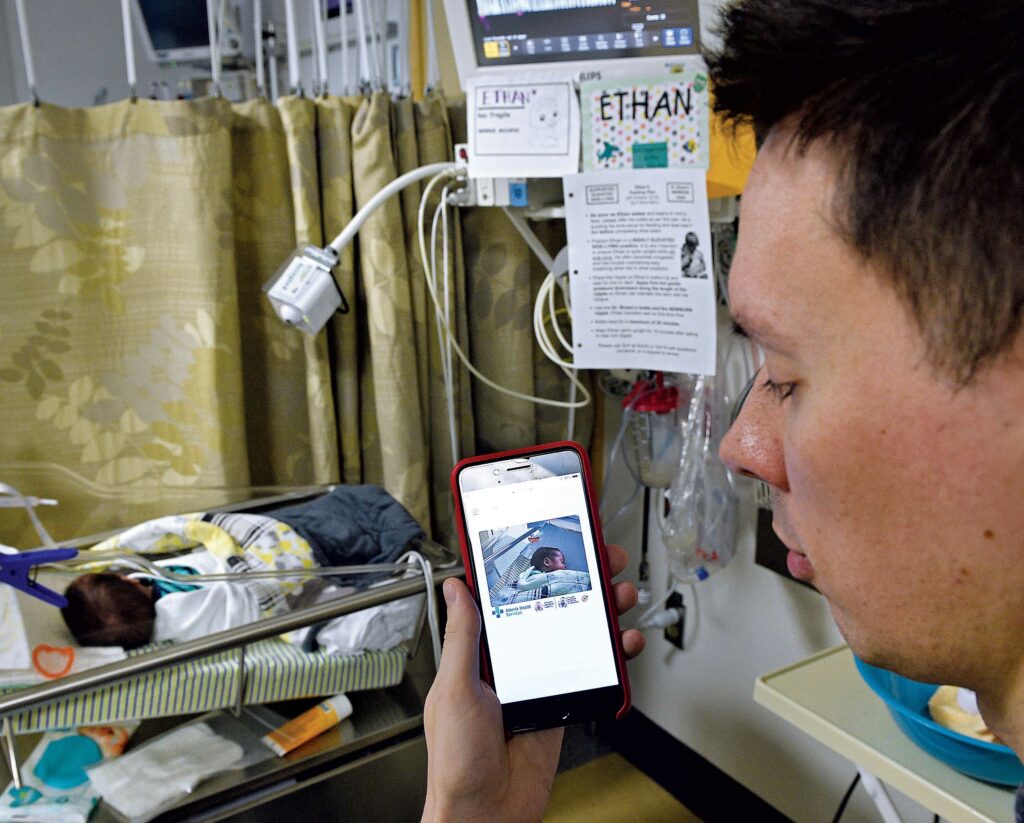
Virtual visits
NICView cameras bring a sense of comfort and relief to parents and family members.
BY KARIN OLAFSON
Originally published in HEROES Summer 2020
When a newborn baby is critically ill and has to be admitted to the neonatal intensive care unit (NICU), the stress of the situation can be overwhelming for the newborn’s parents. Suddenly, instead of bringing the newest family member home, parents are preparing for a very different kind of parent/child routine. Often, it’s one that involves spending hours in the NICU, worrying about the baby’s health and feeling reluctant to leave the child’s side, even to get a few hours of sleep.
Having a baby in the NICU means parents are confronted with a lot of unknowns, and with that comes a lot of anxieties. But the introduction of NICView in the Stollery’s NICU at the Royal Alexandra Hospital site in June 2019 has helped relieve some of the anxieties these parents feel.
NICView is a camera system connected to the Internet, where each NICU incubator has its own camera. Families can access the livestream video of their newborn from their smartphone, tablet or computer using a private username and password. This means that even when family members can’t be right next to their baby, the livestream video offers them the relief of seeing their newborn as they receive care from Stollery staff.
While the video itself is reassuring for parents who can’t be at their baby’s bedside, additional comfort comes from the written messages and care updates NICView displays for the authorized viewers. The Stollery’s cameras display 20 messages and include notes like “I’m eating well,” and “I love you.”
The Stollery Children’s Hospital Foundation raised $245,000 for the 72 NICView cameras in the Stollery Philip C. Etches Neonatal Intensive Care Unit at the Royal Alexandra Hospital site. This is the largest installation of NICView cameras in North America. The Foundation has also funded NICView cameras in the six-bed Stollery NICU at the Sturgeon Community Hospital site, and the Stollery’s David Schiff NICU at the university site.
Courtney Gillis, communications advisor with the Stollery Children’s Hospital Foundation, says that the Foundation funded this technology to further support families with kids receiving care in a Stollery NICU.
“This equipment makes it so that families can have more peace of mind during difficult times,” says Gillis. “Thanks to our donors, our investment in NICView means that families from backyards across northern Alberta and beyond can stay connected to their newborn in critical care, even when they’re not physically with them.”
Gillis says this is especially true for parents who have to travel so their babies can receive world-class care at a Stollery NICU.
Barbara Henderson, a clinical nurse educator at the Stollery Philip C. Etches NICU at the Royal Alexandra Hospital site, gets to see, every day, how this new NICView technology is providing comfort to parents with critically ill babies.
“Parents can login to NICView whenever they like and just watch their baby for a while,” says Henderson. “We’ve seen how it’s a chance [for parents] to rest their mind, knowing that their baby is doing well.”
Henderson adds that she’s seen NICView bring distant family members or loved ones closer together, as anyone with the secure login information can access the livestream video. Family members and friends have logged in from cities across Canada, as well as from countries around the world, to see how the Stollery babies are doing. And it’s an increasingly popular way to stay connected. In the face of the COVID-19 pandemic, NICView has been instrumental, as NICU visitors have been limited.
“When your family is happy, you are happy,” says Henderson. “And if you can make them feel good, then it makes your job even more satisfying.”